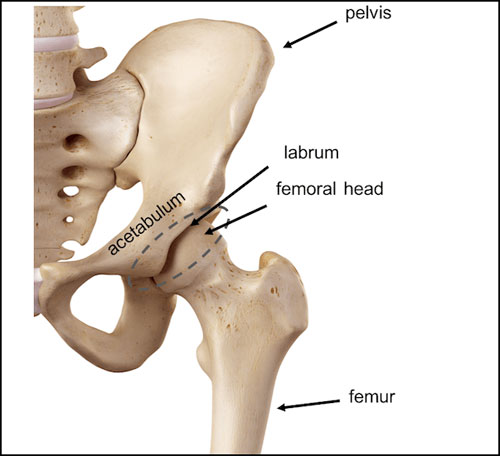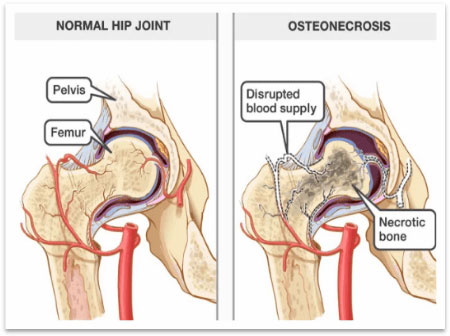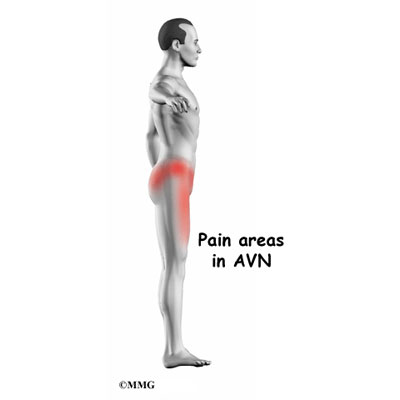Blog
Avascular Necrosis of the Hip Joint
Posted on 17th February 2022
Bones are living tissues. They provide shape and support to the body, protection to internal organs, and store vital minerals. Bones require a continuous blood supply to stay alive. Certain joints of the body, including the hip, have blood vessels that supply blood. When this blood supply is interrupted, it usually results in a condition known as Avascular Necrosis.
Anatomy of Hip Joint:
The hip joint consists of the hip socket (acetabulum) that surrounds the ball of the upper thighbone. The thighbone is called the femur, and the ball on the end is the femoral head.

Image source: https://pathologies.lexmedicus.com.au/collection/femoral-head-fracture-2
Fig.1. Anatomy of the hip joint
The hip joint receives blood supply from the medial femoral circumflex artery (MFCA). This artery further branches into smaller arteries and is the main blood supply to the femoral head. Damage to the blood supply can lead to the death of the femoral head or avascular necrosis of the hip.

Fig.2.Avascular Necrosis of the hip joint
When AVN occurs in the hip joint, the top of the femoral head collapses and begins to flatten. Due to this, the femoral head no longer fits perfectly inside the socket and leads to severe hip bone pain.
Causes of AVN:
Common causes of AVN include:
- Trauma or injury
- Excessive alcohol consumption
- Regular smoking
- Long-term use of steroids
- Chemotherapy & Radiation
- Certain medical conditions such as pancreatitis, sickle cell anemia, Gaucher’s Disease.
Symptoms:
The patients diagnosed with AVN often suffer from:

- Pain in the groin & buttocks radiating to the knee
- Stiffness of hip joint
- Limping while walking
- Restricted range of motion
- Deterioration of the joint
- Reduced mobility of the hip
The early stages of AVN are often painless and asymptomatic. However, as the disease progresses, the pain becomes more evident.
Diagnosis:
The diagnosis of AVN involves a physical examination and diagnostic imaging techniques. During a physical examination, doctors check for any swelling or tenderness and the movement of the joint.
The common diagnostic imaging techniques used for the detection of AVN are X-rays, MRI, and bone scans.

AVN Treatment:
The treatment goal for patients diagnosed with AVN is to prevent further bone loss. In the early stages of Avascular Necrosis, the doctors may recommend the following treatment:
A.Non-surgical Treatment
The non-surgical treatment options include NSAIDs, lipid-lowering drugs, blood thinners, exercises, electrical stimulation.
B.Surgical Treatment
The surgical treatment options for AVN include core decompression, bone grafting, bone reshaping, total hip arthroplasty, regenerative medicine.
OSSGROW Bone Cell Therapy
OSSGROW® by Regrow Biosciences offers a permanent cure to AVN. It halts the progression of AVN and restores mobility. It uses the patients' own cells (autologous) as a therapeutic tool.
Benefits:
- It is a natural and biological therapy
- It is pain-free and has no side effects
- The patient can resume active, pain-free & normal life
- It eliminates the need for total hip replacement therapy
- It ceases the progression of the disease
- More than 500 patients across the country are successfully treated
Get Relief from Hip Pain Today!
If you are suffering from persistent hip bone pain and need an expert opinion on your hip pain, consult our orthopedic doctor today.
Our doctors from AVN Clinics are here to help you and provide you with the necessary care for your ailment.
Get the relief you are seeking with the help of AVN Clinics.
References:
< Back To Blog